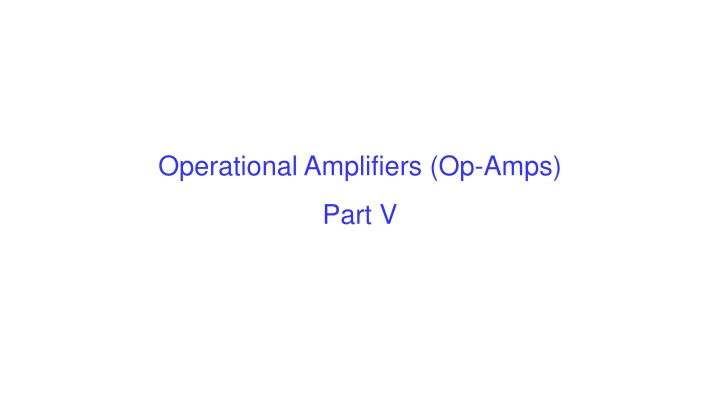
Operational Amplifiers: Feedback and Gain Control
Explore the concept of negative feedback in operational amplifiers, learn about the advantages it offers, understand virtual short and virtual ground, and discover how op-amps function as inverting amplifiers in closed-loop configurations. Calculate gain and output voltage for an inverting op-amp circuit using the provided resistance values and input voltage.
Download Presentation

Please find below an Image/Link to download the presentation.
The content on the website is provided AS IS for your information and personal use only. It may not be sold, licensed, or shared on other websites without obtaining consent from the author. If you encounter any issues during the download, it is possible that the publisher has removed the file from their server.
You are allowed to download the files provided on this website for personal or commercial use, subject to the condition that they are used lawfully. All files are the property of their respective owners.
The content on the website is provided AS IS for your information and personal use only. It may not be sold, licensed, or shared on other websites without obtaining consent from the author.
E N D
Presentation Transcript
Negative feedback Feedback is the process of feedingback a very small portion of the output signal back to the input. In order to make the feedback negative, the output signal must be feed back to the negative or inverting input terminal of the op-amp using an external feedback resistor called RF.
Advantages of Negative feedback It stabilizes gain Increases the bandwidth Reduces the distortion The limitation of negative feedback is that it decreases gain of the amplifier.
Concept of Virtual Short According to virtual short concept, the potential difference between the two input terminals of an ideal op-amp is zero. In other words both the terminals are nearly at the same potential. Since, the input impedance of an ideal op-amp is infinite. Therefore, current flowing from one input terminal to the other will be zero. Thus, the voltage drop across Zinwill be zero and both the terminals will be at the same potential. It simply means both the input terminals are virtually shorted.
Concept of Virtual Ground If one of the terminal of op-amp is connected to ground then due to the virtual short existing between the other input terminal, the other terminal is said to be at virtual ground.
Op-amp as an Inverting Amplifier (Closed Loop) (The non-inverting input is at real ground here, and the inverting input is at virtual ground.) V+ V-- , V-- 0V By applying KCL at point x ?1+ ( ?2)+ (-?3) = 0 ?3= 0 Since, input impedance of an ideal op-amp is infinite. ?1 ?2= 0 ?1= ?2
By using Ohms Law ?1=?? 0 ?1=?? ?1(1) ?2=0 ?0 ??= ?0 ??(2) By comparing eqns. (1) and (2) ?? ?1 = ?0 Gain=??? =?0 ?? ??= ?? ?1
Calculate the gain and output voltage for the Inverting op-amp if RF is 100k and R1 is 10k . The input voltage is 0.5V. Gain = -RF/ R1 Gain = -100/ 10 Gain = -10 Output Voltage = (Gain)(Input Voltage) Output Voltage =(-10)(0.5) Output Voltage = -5V
Find the value of RF, if the gain of the amplifier in the given circuit is -20. Given R1 = 10k = 10000 Gain = -RF / R1 -20 = -RF/10000 RF = (20)(10000) RF = 200000 RF = 200k
References 1. Ramakant A. Gayakwad, Op-Amps and Linear Integrated Circuits, Pearson, 2000. 2. Robert L. Boylestad, Louis Nashelsky, Electronic Devices and Circuit Theory, Pearson, 2013.
